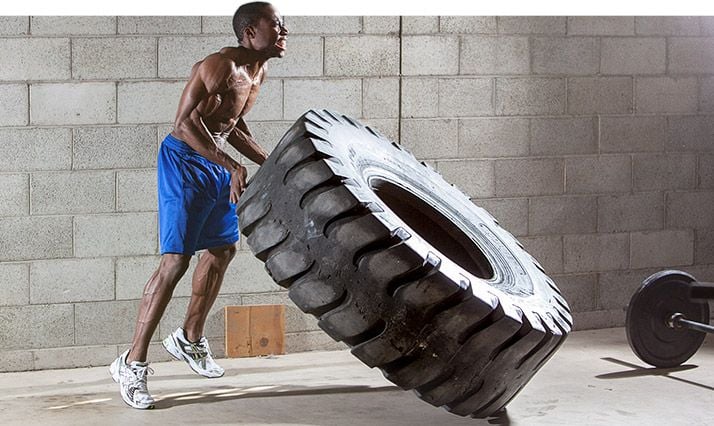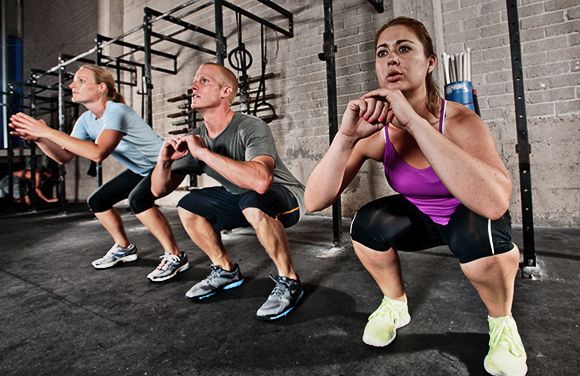Table of Contents
What if we say you can get even better results in a short time with high-intensity interval training? There is not a single reason why you should not love HIIT training plan. This scientifically proven effective training plan keeps your heart rate elevated, torch your calories and burns fat really fast!
When talking about cardio training, high-intensity interval training or HIIT, we need to mention its popularity in fitness world. Even it has nothing to do with the hired killers, your body fat might feel as their victim.
This type of cardio training varies high-intensity exercises (e.g. steady run) with low-intensity exercises (e.g. slow walk) and with recovery periods. This training style is a pleasant change from continuous steady-state cardio training, usually at a moderate intensity for 30-60 minutes per session. You run (or cycle or whatever else) like a fool on a shorter distance, but with a bigger effort, so you can get better results in a shorter time.

HIIT was developed by coaches dozens of years ago for conditioning runners. It was known as a “Fartlek” training. Its name was created by combining swedish words as “speed” (fart) and “play” (lek). So it basically means “speed play”, what perfectly describes what HIIT training actually is.
Increasing number of studies
HIIT has gained its popularity due to many beneficial results as well as in published research studies. Some studies are even comparing HIIT with continuous steady-state training, proving that HIIT trainings are definitely better and more effective for fat-burning, despite less time required.
One of the first research about HIIT effectivity was done in 1994 by research workers from Laval University (Ste-Foy, Quebec, Canada). This research compared young men and women following either 15-week HIIT training plan or 20-week continuous endurance training plan. Men and women with 15-week HIIT training plan lost much more body fat than others following 20-week continuous endurance training plan, although this endurance training plan burned 15 000 calories more than HIIT training plan.

Losing 2 % of body fat in 8 weeks
Another study by East Tennessee State University was done in 2001. It found similar results with obese group of people, who followed 8-week HIIT training plan (this group lost 2 % of body fat) comparing to another obese group who followed continuous training plan on treadmill (this group did not lose any fat at all).
You will lose 6 times more body fat
Australian study discovered the fact, that women following 20-minutes HIIT training plan consisting of 8 seconds sprints and 12-second recovery periods, lost six times more body fat than women who followed 40-minutes cardio training plan performed in constant intensity of 60% maximum heart rate.

Why is HIIT training plan more effective than steady-state cardio activity in body fat losing? It looks like the main reason is its ability to boost resting metabolic rate after HIIT training.
No rest for your metabolism
Another study by Baylor College of Medicine (Houston, TX) in 1996 stated that group following HIIT training using stationary bike burned much more calories in 24 hours of training than another group following steady-state intensity plan using stationary bike as well.
Burn 100 calories more!
Next study was presented by Florida State University (Tallahassee) in 2007 at American College of Sports Medicine annual meeting. Researchers stated that group following HIIT burned almost 10% more calories in 24 hours of training than group following steady-state exercise, although the amount of calories burned during the training was the same.

Boosting fat-burning process
HIIT training is effective for increasing rest metabolic rate, it alsoincreases metabolic activity in muscle cells that support fat burning and blunt fat production.
Fat-burning muscles
Research by Laval University confirmed relation between fat burning and HIIT training. Moreover, it discovered that muscle fibres of HIIT plan followers had much better results for fat oxidation (fat-burning) that muscle fibres of steady-state training plan followers.
How to lower fat level
Research by Norwegian University of Science and Technology (Trodheim) claimed that group with metabolic syndrome, following 16-week HIIT training plan, gained 100% better result in reducing fatty acid synthase than group following moderate intensity training plan.

Use your fat as a source of fuel for exercise
A new study published in American Journal of Physiology explains another reasons of how HIIT training burns more body fat. Researchers say 6-week HIIT training plan is able to increase the amount of special proteins in muscles that carry fat into the mitochondrias (where fat is used as a source of fuel) by up to 50%. If there are more special proteins in your muscles, more fat may be burned and used as a source of fuel during exercise, but also when recovering.
Is HIIT also hit for bodybuilders?
Yes, it definitely is. Many bodybuilders and trainers claim that slower and longer cardio is better for fat-loss and muscles protection, even it is not true.
High-intensity cardio training done for a shorter time will help you to maintain your muscles. If you train at a steady and slow pace for a longer period, you train your muscle fibres to be more aerobic and have greater endurance.

Have you ever thought about how muscle fibres adapt to be more aerobic and to gain greater endurance? They become smaller and weaker. The smaller they are, the less time they need for nutrients to move within them. It also shorter the period of using these nutrients as a source of a fuel.
Think about it, it absolutely makes sense. Stating that slow, steady and longer cardio is the best for maintaining lean body mass is the same as stating that curling 2 kg dumbbells for 30 minutes build more muscle mass that curling 18 kg dumbbells for sets of 10 reps with two minutes of rest between these sets. High-intensity trainings surely build muscles better. If you really think about it, weightlifting is also form of high-intensity interval training. A lot of researches stated the same.
HIIT and beta-alanine for massive muscle gain
Study in Journal of the International Society of Sports Nutrition stated that male subjects following a 6-week HIIT plan (done for 15 minutes a day at a 2:1 ratio of exercise and rest, three days a week) supplementing beta-alanine gained more than 1 kg of muscles after only three weeks, even they did not lift during the plan.

Boost your testosterone with HIIT training plans
Another study, done by researchers in New Zealand, is about competitive cyclists completing 4-week HIIT training plan that involved 30 seconds of sprint on a stationary bike and 30 seconds of recovery period. One of the groups sprinted with high resistance on the pedals. It was harder to pedal. Second group used lighter resistance. Both groups peddled as fast as they could for the period of 30 seconds.
Researchers found that the men who peddled at the highest resistance gained increasing testosterone levels by almost 100%, while another group that peddled at the lighter resistance gained increasing testosterone levels only by almost 60%. We need to mention that testosterone is critical for boosting size and strength of the muscles. Therefore HIIT training at higher resistance may help to muscle growth and strength.

HIIT training helps to maintain sanity by getting it done quicker. Many people consider 30-minutes activity on a treadmill, stationary cycle or elliptical machine as a very monotonous activity. Intensity of HIIT exercise might be more challenging, but is also short and stimulating. It is exactly what makes your training more funny, moreover it is completed quicker.
Another benefit of HIIT exercise is its ability to be done almost anywhere with any piece of equipment – or even without it. HIIT might be also done in the gym using cardio machines. The possibilities are basically limitless. Try to use a jump rope, weights, elastic bands or just your bodyweight!

Give HIIT training plan a chance, try to do less long cardio workouts. The benefits of HIIT trainings are fat-loss due to the better resting metabolism rate, fat-burning enzymes and muscle building. In addition, all in a minimal period of time.
8-week HIIT training plan: from the beginner to advanced
This plan will help you to get from HIIT beginner to HIIT advanced in only 8 weeks.
- Plan starts with phase 1, ratio of 1:4 for work and rest. Total workout time is under 15 minutes.
- Second phase increase the amount of work time to ratio of 1:2 for work and rest. Total workout time is about 17 minutes.
- Rest ratio is in phase 3 cut in half, so this phase ratio is 1:1 for work and rest. Total workout time increases to 18,5 minutes.
- Finally, rest time is cut in half again, phase 4 has ratio of 2:1 for workout and rest. Total workout time increases to 20 minutes, this is already advanced level of HIIT workout.

All of the times mentioned above are only suggestions, in case you need more than two weeks for a particular phase before moving to next phase. If you think actual phase is too simple, you can easily move to the next one.
These workout may be done using equipment such as stationary bike, jump rope, doing jumping jacks or running. Use imagination and simply follow intervals of work and rest.
Phase 1 (1:4)= weeks 1-2
- 15 seconds: high-intensity exercise
- 60 seconds: rest or low-intensity exercise
Repeat 10 times, finish with 15-second high-intensity blast.
Total time: 14 minutes

Phase 2 (1:2)= weeks 2-4
- 30 seconds: high-intensity exercise
- 60 seconds: rest or low-intensity exercise
Repeat 10 times, finish with 30-second high-intensity blast.
Total time: 17 minutes
Phase 3 (1:1)= weeks 5-6
- 30 seconds: high-intensity exercise
- 30 seconds: rest or low-intensity exercise
Repeat 11 times, finish with 30-second high-intensity blast.
Total time: 18,5 minutes

Phase 4 (2:1)= weeks 7-8
- 30 seconds: high-intensity exercise
- 15 seconds: rest or low-intensity exercise
Repeat 25 times, finish with 30-second high-intensity blast.
Total time: 20 minutes
Will you try our 8-week HIIT challenge? It will be worth it! If you want to know more information about HIIT trainings, read another article about 5 secrets of HIIT exercise you need to know or 6 reasons to try HIIT. Have you ever tried any HIIT exercise? Let us know in comments below, we would be glad to hear about your experience. If you like this article, do not hesitate to share it.
Main source: bodybuilding.com
Sources:
• Boutcher, S. H. et al. The effect of high intensity intermittent exercise training on autonomic response of premenopausal women. Medicine & Science in Sports & Exercise 39(5 suppl):S165, 2007.
• Gorostiaga, E. M., et al. Uniqueness of interval and continuous training at the same maintained exercise intensity. European Journal of Applied Physiology 63(2):101-107, 1991.
• King, J. W. A comparison of the effects of interval training vs. continuous training on weight loss and body composition in obese pre-menopausal women (thesis). East Tennessee State University, 2001.
• Meuret, J. R., et al. A comparison of the effects of continuous aerobic, intermittent aerobic, and resistance exercise on resting metabolic rate at 12 and 21 hours post-exercise. Medicine & Science in Sports & Exercise 39(5 suppl):S247, 2007.
• Paton, C. D., et al. Effects of low- vs. high-cadence interval training on cycling performance. Journal of Strength and Conditioning Research 23(6): 1758-1763, 2009.
• Smith, A. E., et al. Effects of ?-alanine supplementation and high-intensity interval training on endurance performance and body composition in men; a double-blind trial. Journal of the International Society of Sports Nutrition 6:5, 2009.
• Talanian, J. L., et al. Exercise training increases sarcolemmal and mitochondrial fatty acid transport proteins in human skeletal muscle. Am J Physiol Endocrinol Metab IN press, 2010.
• Talanian, J. L., et al. Two weeks of high-intensity aerobic interval training increases the capacity for fat oxidation during exercise in women. Journal of Applied Physiology 102(4):1439-1447, 2007.
• Tjonna, A. E., et al. Superior cardiovascular effect of interval training versus moderate exercise in patients with metabolic syndrome. Medicine & Science in Sports & Exercise 39(5 suppl):S112, 2007.
• Trapp, E. G. and Boutcher, S. Metabolic response of trained and untrained women during high-intensity intermittent cycle exercise. Am J Physiol Regul Integr Comp Physiol. 2007 Dec;293(6):R2370-5.
• Treuth, M. S., et al. Effects of exercise intensity on 24-h energy expenditure and substrate oxidation. Medicine & Science in Sports & Exercise 28(9):1138-1143, 1996.


Add a comment